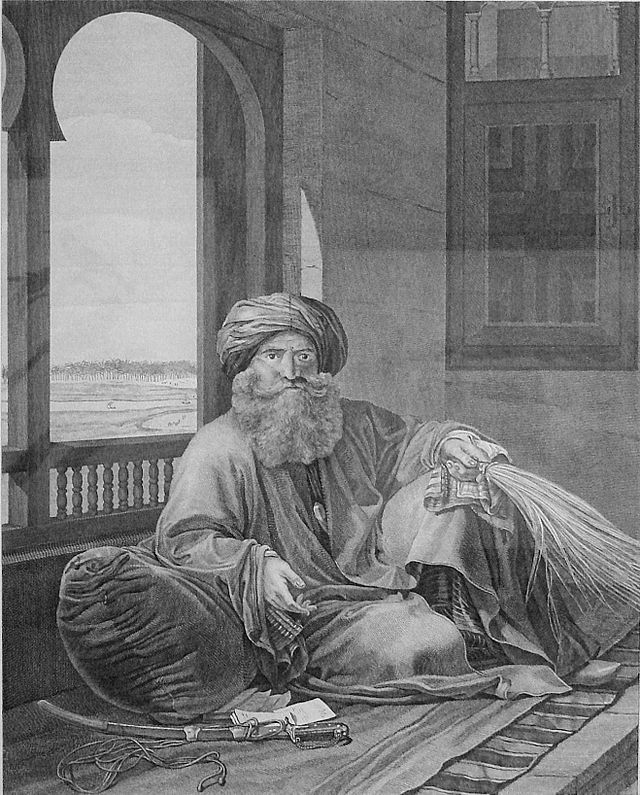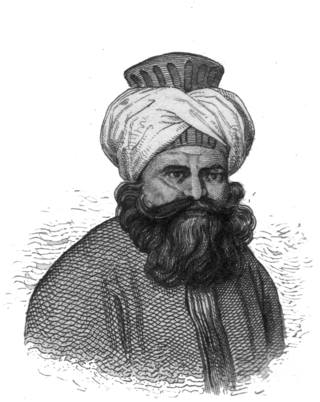Murad Bey
Egyptian ruler From Wikipedia, the free encyclopedia
Murad Bey (c. 1750 – 22 April 1801) was an Egyptian Mamluk chieftain (Bey), cavalry commander and joint ruler of Egypt with Ibrahim Bey.[1] He is often remembered as being a cruel and extortionate ruler, but an energetic courageous fighter.[1]
The title given to him, "Bey", denotes an aristocratic status broadly indicative of "Lordship", subject to the cultural norms of the Ottoman Empire. More specifically, the cultural norms of the Egyptian province in the Ottoman Empire, since Egypt enjoyed varying degrees of autonomy throughout the Ottoman period.
Biography
Summarize
Perspective

While many Georgian and foreign historians claim Murad was of Georgian origin and born in Tbilisi,[2][3] several others believe he was a Circassian.[4] In 1768, he was sold to the (Circassian) Mamluk Abu al-Dhahab, regent of Ottoman Egypt.
After the death of his master in 1775, Murad Bey was in command of the Mamluk army, whereas Ibrahim Bey was in charge of the administrative duties of Egypt.[5] They survived through the persistent Ottoman attempts at overthrowing the Mamluk regime and civil strifes.[2] They served as kaymakams (acting governors) in Egypt on occasion, although they effectively held de facto power for decades, even over the appointed Ottoman governor of Egypt.[6][7][8]
In 1786, the Ottoman sultan Abdülhamid I sent Kapudan Pasha (grand admiral of the Ottoman Navy) Cezayirli Gazi Hasan Pasha to drive out Ibrahim and Murad Bey.[9][10] Hasan Pasha was fervent and thorough in his efforts and succeeded in the short term, reestablishing direct Ottoman Empire control over Egypt.[9] Ismail Bey was appointed as new Mamluk leader and Shaykh al-Balad (civil governor and de facto ruler). However, in 1791, only five years after their expulsion by Hasan Pasha, the duumvirate returned to Cairo from hiding in southern Egypt and took back de facto control.[11] At this time, Murad Bey served as the amir al-hajj (Commander of the Hajj),[12] a position responsible for securing funds and provisions for the yearly Hajj pilgrimage and protecting it along the desert route to Mecca and Medina in the Hejaz.
Murad commanded the Mamluk cavalry and janissary infantry in the Battle of Shubra Khit on 13 July 1798, but he was defeated by the French army and withdrew from the fight. Eight days later, on 21 July, he commanded the Mamluk cavalry during the Battle of the Pyramids alongside Ibrahim Bey and was defeated by Napoleon. While Ibrahim Bey fled towards the Sinai Peninsula, Murad fled to Cairo and then Upper Egypt. He mounted a brief guerrilla warfare that staved off the armies of Louis Desaix for a year.[5] While pursuing Murad Bey into Upper Egypt, the French discovered the monuments at Dendera, Thebes, Edfu, and Philae.
Murad had reportedly offered money to the French forces to leave Egypt. He offered to ally himself with the British Empire in exchange for allowing them to occupy Alexandria, Damietta, and Rosetta.[1] In 1800, Murad made peace with Jean-Baptiste Kléber. He agreed to garrison Cairo.[2] He was responsible for collecting taxes from Upper Egypt on behalf of the French First Republic. He was part of the French army at the Battle of Heliopolis, commanding his Mamluks on the French right wing. He deserted the French before the battle and did not participate in the fighting. After the French army was defeated at Canopus by a British army under Ralph Abercromby, the French governor of Cairo, Augustin Daniel Belliard, ordered Murad Bey to assist him in defending the capital. Murad set out to assist the governor but died en route of the bubonic plague.
See also
Wikimedia Commons has media related to Murad Bey.
- Ibrahim Bey (Mamluk), his career-long partner in ruling Egypt
- Nafisa al-Bayda, his wife who served as his go-between during the French occupation
References
Wikiwand - on
Seamless Wikipedia browsing. On steroids.

